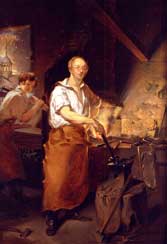The Right
to Right Wrongs
The 5th article of the charter ensured "that all Criminals shall
have the same Priviledges of Wittnesses and Councill as theire Prosecutors."
Two landmark civil liberties cases, Patrick Lyon's alleged robbery of
the Bank of the Pennsylvania in 1798, and Passmore Williamson's assistance
to an enslaved woman seeking freedom in 1855, tested the ability of
Pennsylvania authorities to protect individual rights against governmental
power. Though both plaintiffs suffered significant injustices, both
sued successfully for redress, in the process shaping the changing laws
of their times.
|

Painting
Study for the Second Version of Pat Lyon at the Forge
John Neagle, Philadelphia, 1828
Oil on paper laid down on canvas, mounted on masonite
Purchase, 1900
On September 1, 1798, the Bank of Pennsylvania (a painting
of which hangs in the Society's grand stairwell) was robbed of $162,821.61.
Patrick Lyon, a blacksmith and recent immigrant from England, was jailed
as the primary suspect since he had made the doors and locks to the
vault. Ultimately vindicated, Lyon went back to his forge and became
a well-respected citizen. In 1825 he commissioned a full-length portrait
from artist John Neagle, requesting, "I want you to paint me at
work at my anvil…."
|

